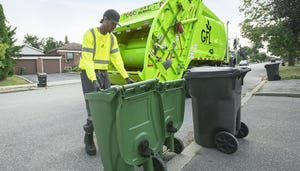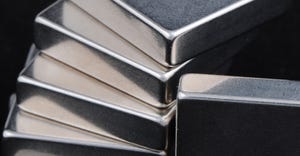Wheelabrator Technologies’ Watsford Works to Grow WTE Infrastructure
The Waste360 40 Under 40 award recipient discusses her role at the company, how technology has changed the industry and the value of WTE.
Wheelabrator Technologies, a company that converts municipal solid waste and other renewable waste fuels into clean energy, is working to build upon its waste-to-energy (WTE) infrastructure and operations. And one of the leaders of that effort is Julia Watsford, the company’s vice president of corporate strategy and market planning.
For the past three years, Watsford has worked to develop and execute the company’s corporate strategy, which aims to drive growth and productivity. And most recently, she has helped organize, manage and engage in a number of projects, including three WTE facilities under construction in the U.K.
“Julia’s most admirable quality is her tenacity. She is a results-driven, experienced executive combining strong business and financial acumen to achieve rapid turnaround, recurring bottom line savings and strong growth,” says Robert Boucher, president and CEO of Wheelabrator. “She employs a strategic mindset with a unique and proven ability to translate strategy into execution and deliver organic and inorganic growth strategies. Watsford has a demonstrated ability to design and build teams, recruit, retain and develop talent and build employee engagement and team accountability. She has a strong technical background with demonstrated experience in process optimization, business transformation and strategy formation. She also brings to Wheelabrator the exceptional capacity to absorb information quickly, rationalize, organize and manage and engage in multiple projects. Finally, her ability to distill the ‘so what’ of the many influences our company and industry faces into clearly articulated, actionable strategies makes her an invaluable leader.”
This year, Watsford was presented with a Waste360 40 Under 40 award, and she recently spoke with us about her role at the company, how technology has changed the industry and the value of WTE.
Waste360: How long have you been in the waste and recycling industry and how did you get your start?
Julia Watsford: I have worked in the waste management industry for about five and a half years, and I got my start in Australia as a management consultant at Price Waterhouse Coopers. I worked on a project for a publicly-traded waste collection company and ended up running a fleet remobilization project there for a couple of years. Through that process and a number of other engagements at the company, I started working on the 100-day plan and strategy for the now CEO of Wheelabrator, when he came on board back here in the U.S. As part of that experience, I transitioned from being a consultant to a full-time employee at Wheelabrator, and I have now been with the company as part of the senior leadership team for over three years.
Waste360: Explain your role as vice president of corporate strategy and market planning.
Julia Watsford: My role has a wide range of responsibilities. Ultimately, I am responsible for the internal and external corporate strategy of the organization and how we execute on that strategy. I support the CFO and CEO in driving the strategic agenda of the organization.
I am responsible for market planning, which is a strategic planning process around the way we look at the waste supply that comes into our WTE facilities and our understanding of the different supply sources in each of our markets.
I also have responsibility for procurement and supply chain, which manages the purchase of goods and services to support our fleet of 19 WTE facilities across the U.S. and the U.K, including our three facilities under construction in the U.K.
In addition, I am responsible for communications and community engagement, which again ties into our internal and external corporate strategy and ensuring we engage with the communities in which we operate and serve.
Lastly, I am responsible for the project management office, which oversees 25 strategic, cross-functional projects within the organization. Those projects include greenfield and brownfield business development opportunities of new WTE facilities, the construction of our three WTE facilities in the U.K. and multiple cost reduction and revenue improvement projects.
Waste360: When you first started in your role, you helped realign and restructure the business under new ownership (Energy Capital Partners). Come 2019, the company will be under new ownership again (Macquarie Infrastructure Partners). Do you anticipate having to do another round of adjustments as a new owner takes over?
Julia Watsford: For now, it really is business as usual at Wheelabrator. The initial change and restructuring that we did under the ownership of Energy Capital Partners (ECP) was really a function of the fact that Wheelabrator had previously been a division within Waste Management, so it was about setting the business up to stand on its own two feet as a standalone business and making sure that the organization had a clear vision, set of values and defined strategic priorities for the team to follow and deliver upon. The majority of the changes that we made in 2016 were focused on our corporate office and making sure that we were structured as efficiently as possible to support the underlying operations at our facilities. Those strategic priorities have remained in place over the last three years, and I expect they will continue to remain in place moving forward.
Wheelabrator has an amazing track record and a history of operational excellence in both the U.S and the U.K, and that is what makes it such an attractive partner in the communities that we operate and a business to ultimately own. Pending close of the transaction, we will simply have a longer-term owner, who, like ECP, is invested in seeing the continued growth of the organization.
Waste360: WTE makes up a small portion of the U.S. waste and recycling industry. How is Wheelabrator working to expand its WTE efforts and to get others to support those efforts?
Julia Watsford: Education is critical for WTE to continue to grow and succeed in the U.S. At Wheelabrator, we spend a lot of time engaging in the communities in which we operate to help them understand the value of WTE. It’s critically important to us to be a good neighbor, support local schools and community groups, host tours of our facilities and be involved in different ways so that community members can learn about sustainable waste management, clean power generation, the value of the waste hierarchy and the available options for reuse and recycling. And that’s why research shows that communities with WTE have higher recycling rates than those that don’t.
WTE is renewable because our fuel source, post-recycled waste, is sustainable and non-depletable, and we provide a way to convert the energy in non-recyclable materials into electricity and heat. The more that we can educate the public about the environmental benefits of WTE—reducing greenhouse gas emissions, avoiding carbon dioxide generation from burning fossil fuels and avoiding methane generation from landfill—the better.
Waste360: Since joining the company, how have you seen technology change the business and/or the industry as a whole?
Julia Watsford: The interesting thing about WTE is that the mass burn technology that we employ at our facilities here in the U.S and also in the U.K. look and feel very similar—why? Because the fact is that the technology has been proven to be the best and most efficient way to process post-recycled waste. If you walk through the first commercial WTE facility in the U.S., Saugus, and then walk through our most recently built WTE facility in the U.K., Ferrybridge 1, the fundamentals of the process are very much the same; however, the improvements in certain technology are noticeable.
The real impact of technological change though is in how we continue to optimize our operations, achieve efficient combustion and gain better insight into how we best maintain our facilities to ensure that they can operate indefinitely. At Wheelabrator, we’re really focused on how we leverage technology and take a more data-driven approach to how we ensure our facilities are maintained to the highest quality, in order to last indefinitely and provide an indefinite source of sustainable waste management to the communities in which we operate.
More recently, we have made large investments in new technology for the recycling of metals from our facilities and invested in two advanced metal recovery systems and a central upgrade facility at our ash monofills in the U.S. to allow us to recycle further ferrous and non-ferrous fines from the waste stream.
Waste360: What’s your proudest accomplishment in your career so far
Julia Watsford: I am so proud of what we’ve been able to achieve at Wheelabrator, and I’m incredibly thankful of the opportunity that I had—to be involved in defining the 100-day plan and strategy that the company is now successfully executing.
The culture at Wheelabrator was and has been fantastic—but being able to build upon that culture with clear, strategic priorities has made the company an even greater organization and, I hope, a greater place to work. I’m proud that I have been able to play such a role in helping make the organization what it is today, and what it will be for at least the next 40 years.
Waste360: What advice would you give to someone interested in joining the WTE side of the industry?
Julia Watsford: I think WTE is such an interesting industry, as it brings together a lot of different technical capabilities but also has the feel-good factor of doing something really good for the environment and creates sustainable solutions for how we manage our waste.
Individuals looking to understand the industry and get involved in WTE should know that we offer tours and internships at a number of our WTE facilities. Internships are great opportunities because they allow you to get inside the business and understand how it works and what opportunities really exist.
From me though, my advice would be that it’s really about getting out there and educating yourself about the industry, the business, the process and the role you can play. We’re always looking for ways to bring in the next generation of leaders—and I’m excited to talk to the new generation that wants to work on WTE about what it is and why Wheelabrator is the right company to work for.
Waste360: The industry is currently undergoing a lot of changes. What exciting opportunities do you think exist for the future of the industry?
Julia Watsford: I think the exciting opportunities in the space are really going to be around how we as a society continue to grow and think about sustainable waste management infrastructure. For me, that really isn’t about one type of waste treatment versus another. To have a fully sustainable waste management system, you need multiple components. And the beauty of WTE is that it has the ability to take and process post-recycled materials that could not be recycled—and processes those in the most efficient and environmentally friendly way. As more and more different types of waste come out of the waste stream, the value of WTE being a part of the waste infrastructure becomes even more important.
I hope to see continued support for WTE and support for the development of new WTE facilities as communities look to redefine their solid waste management plans and think through how to have more comprehensive waste management infrastructure in the U.S.—am I biased, yes. But am I right, yes.
About the Author(s)
You May Also Like




